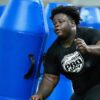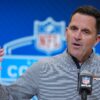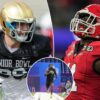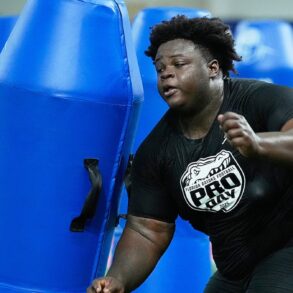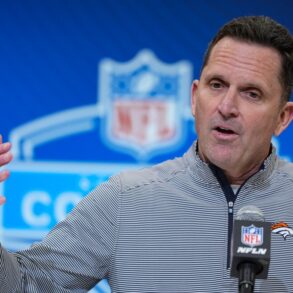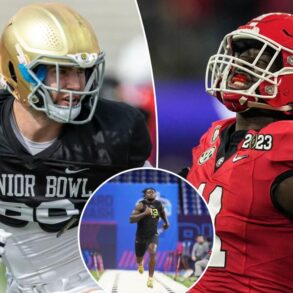The final installment of my dynasty rookie rankings is for the most important position in football: quarterback.
Though the things that make a quarterback good for fantasy football are often different than the characteristics of a successful real-life passer, in dynasty, having a quarterback who starts for a decade is better than having one who scores 30 points three times and never gets another shot.
Other dynasty rankings during this series:
2025 Rookie QB Rankings 1-5:
1. Cam Ward, Miami
The presumptive No. 1 overall pick has had a circuitous route to the NFL, getting his start at FCS school Incarnate Word after going overlooked by scouts. He immediately proved to be in a class of his own, leading the FCS with 24 passing touchdowns in six spring games due to COVID. Ward continued playing on easy mode as a sophomore, throwing over 200 more times than any other FCS passer. Naturally, he lapped the field in production, throwing for 4,650 yards and 47 scores. That was over 1,500 more yards and 19 more touchdowns than the No. 2 FCS passer, Shedeur Sanders. Ward then got called up to FBS ball at Washington State, another pass-first squad. While his production—3,232 yards and 23 scores—was good, Ward struggled to adapt to the Cougar’s underneath passing attack. His aDOT dropped by over a yard to seven and, in turn, he went from a Big Time Throw rate—as charted by Pro Football Focus—of 3.9 percent at Incarnate Word to 1.9 percent at Washington. His Turnover Worthy Play rate, on the other hand, did not budge. The Cougars let him push the ball downfield in 2023 and all of his numbers rose. He led the FBS in passing yards at 3,736 while averaging 8.1 adjusted yards per attempt.
Ward made his way to Miami for a final season of college ball, and the Canes took the restrictor plate off, upping his aDOT to a staggering 9.8. He finished the year top five in attempts, yards, touchdowns, and YPA. Ward recorded career-high marks in deep throw rate (16.5 percent) and intermediate throw rate (25.1 percent). PFF graded him as a top-three passer on both depths. To consistently push the ball downfield, Ward was holding onto the ball for ages. He had the 10th-longest time to throw at 2.93 seconds but evaded sacks well. Just shy of 16 percent of his pressured dropbacks resulted in a sack. That is an above-average mark for anyone, let alone a player executing a hero ball style. Ward doesn’t just move around behind the pocket. Removing yards lost to sacks, he rushed for at least 300 yards in four straight seasons.
As expected with a gunslinger type, Ward’s short-area accuracy leaves something to be desired. He sidearms throws from time to time, resulting in inconsistency on throws that should be nearly automatic. He ranked 51st in PFF’s accuracy rating and 50th in accuracy plus rating on throws between 1-9 yards downfield last year. Ward earned stellar marks on his intermediate and deep throws. For better or worse, Ward is going to do everything he can to find the big play. That worked for him in college and has earned him to vaunted Patrick Mahomes comp more than once.
Courtesy of CFB Numbers
At the bottom end of that spectrum, however, is Zach Wilson, who also tried to win the game on every dropback. Ward likely falls somewhere in the middle alongside Baker Mayfield and Blake Bortles.
2. Jaxson Dart, Ole Miss
Dart was a four-star recruit for USC but didn’t play much as a freshman and then transferred to Ole Miss after USC landed Caleb Williams in the transfer portal. Dart joined Lane Kiffin’s quarterback-friendly offense and got better every year. He threw for 2,974, 3,364, and 4,279 yards in three seasons as a Rebel. Dart led the country with 11.5 AY/A and a 180.7 Passer Rating in 2024. Not just a pocket passer, Dart is incredibly mobile, rushing for 1,915 yards and a dozen scores across his three seasons as a starter.
At 6’2/223, Dart isn’t massive, but he has the build and the arm strength of a plus NFL starter. PFF graded Dart as their No. 20 deep passer last year and he earned that grade while leading the nation in deep attempts. The volume/efficiency combo fueled him to the most passing yards (1,517) and touchdowns (17) on deep throws in the FBS. Dart was also PFF’s No. 1 intermediate thrower. Successfully working the deep and intermediate portions of the field led him to a top-five finish in EPA per dropback. Over 50 quarterbacks logged at least 400 dropbacks last year and Dart was the only one charted with a Big Time Throw rate over seven percent.
Dart was one of the most accurate quarterbacks in the country while also being one of the most aggressive. His career pressure-to-sack rate of 15.1 percent is good, but that number rose over 19 percent in each of his final two seasons.
The common gripe with Dart’s profile is how much he benefitted from Kiffin’s system. Dart was aided by play-action on 53 percent of his throws, the second-highest rate in the nation. He averaged an extra 3.1 yards per attempt on these throws and upped his completion rate by 6.6 percent. Dart was electric when throwing to his first read, averaging 12.1 YPA with the second-highest passing grade in the FBS. Kiffin made sure that the top of his progression was open often and open easily. His YPA fell by nearly five when he was forced to work through his progressions and he graded as PFF’s No. 27 passer on these attempts.
Even when throwing out all play-action looks, Dart still graded out well in 2024. He ranked 10th in PFF’s accuracy rate, 12th in PFF passing grade, and fourth in yards per attempt on non-play-fake throws. His numbers when throwing to anyone other than his first read weren’t elite, but they weren’t a red flag either. Dart has the physical tools and the production of a potential No. 1 overall pick. The handholding of his offensive system makes the evaluation riskier than most passers, but it’s not enough of a knock for me to fade him in rookie drafts.
3. Shedeur Sanders, Colorado
The second of our former FCS quarterbacks in this class, Sanders was a four-star recruit but chose to play at Jackson State under his father. Sanders shredded weak competition for two seasons, throwing for 6,983 yards and 70 scores with just 14 picks. He and many of the other Jacksonville State players followed Coach Prime to Colorado in 2023. It was more of the same for Sanders at Colorado with 3,230 yards and 27 touchdowns as a junior then 4,134 yards and 37 scores as a senior.
Sanders is known as the accurate quarterback of the class and the numbers bear that out. He completed 71.4 percent of his passes at Colorado, giving him the all-time FBS completion rate record. PFF charted him with a 71.6 percent accurate throw rate from a clean pocket, the second-best mark in the country.
Sanders was deadly accurate, but he was also given a relatively easy spread of throws. His 8.1 aDOT ranked 129th in the country and he attempted the second-most screen passes in 2024. Because he wasn’t making many high-risk throws, Sanders was otherworldly at protecting the football. He had a turnover-worthy play rate of 1.3 percent at Colorado.
If you watch any Colorado game, you’ll see a lot of this:
Shedeur Sanders has a bad tendency to drift backwards in the pocket when he doesn’t see things cleanly downfield or when he feels pressure. This puts a lot of strain on his offensive tackles and limits his ability to attack downfield. pic.twitter.com/60ZaMT6u6X
— Nate Tice (@Nate_Tice) March 19, 2025
Sanders loves to fade back and hold onto the ball. He averaged three seconds to throw in his final season and 2.9 seconds for his career. For a quarterback not going deep often, that’s an eternity between snap and release. Sanders’ propensity to hold onto the football despite his middling athleticism led to a pressure-to-sack rate over 20 percent for his final season and career. PFF charted him as responsible for over a quarter of his pressures last year. For reference, Jaxson Dart was responsible for 12 percent of his pressures. The high sack rate tanked Sanders’ efficiency and he finished 2024 at No. 25 in EPA per dropback.
Sanders is a capable athlete, but he lost more yards on sacks than he gained on scrambles at Colorado. He did, however, run for four touchdowns in both seasons. Sanders doesn’t have a special arm or much rushing potential, lowering his ceiling for fantasy purposes and as a real-life passer. His accuracy creates a high floor, but that’s partially counteracted by his sack-taking tendencies. The Teddy Bridgewater comparison many throw out sounds unkind, but Bridgewater was robbed of what was going to be a fruitful career via a gruesome leg injury. Andy Dalton is up to 168 starts and counting and also fits the bill as a Sanders comp.
4. Jalen Milroe, Alabama
Milroe was a two-year starter at Bama whose athleticism defined his play both through the air and on the ground. He ran for over 800 yards in back-to-back seasons and punched in 20 rushing touchdowns as a senior. His accuracy needs work, but the arm strength is on full display. Milroe was graded as PFF’s No. 15 deep passer in 2024 and their No. 2 deep passer in 2023. He also improved drastically as an intermediate thrower last year, going from a 56.0 passing grade as a junior to 91.7 in his final season. His accuracy on short throws was poor in his final season, though he graded out well per PFF as a junior. Milroe lacks touch on his short throws and often winds up throwing a bullet at a receiver a few yards away. He’s not Anthony Richardson levels of inaccurate on the easy attempts, but he needs work.
Taking a lesson from baseball, Milroe is a three true outcomes quarterback. He makes big throws, creates yards with his legs, and turns the ball over. Milroe was intercepted 11 times in 2024, 10 of which came in his eight games of conference play. However, his mistake-prone nature was subdued in other ways in 2024. He only took 23 sacks compared to 44 in 2023. His pressure to sack rate also fell from a staggering 31.9 percent to 18.9 in his final season. This, however, tanked his Big Time Throw rate from 9.1 percent to 5.2 percent.
Milroe compares favorably to previous hyper-mobile passers in several categories, but the sack-taking sticks out as an issue. It’s also a habit that’s hard to kick in the NFL. His career could look eerily similar to that of Justin Fields. We’re going to have a lot of fun in fantasy with Milroe, but it may not last long.
5. Tyler Shough, Louisville
The elder statesman of the class, Shough started his seven-year collegiate career at Oregon as the backup to Justin Herbert. He was a backup for two years before taking over as the starter during a COVID-shorted 2020 season. Shough threw for 1,559 yards, 13 touchdowns, and six interceptions at a solid 9.3 AY/A. Despite playing well in the spreadsheets, he ceded snaps to Anthony Brown late in the year and transferred to Texas Tech after the season. He was named the starter in all three of his seasons as a Red Raider but could never stay healthy, appearing in a total of 15 games with his second team.
One more transfer put Shough at Louisville where he would finally get to start for an entire season. Shough threw for 3,215 yards, 23 scores, and six interceptions. He graded out as PFF’s No. 13 passer and finished the year 12th in the country in EPA per dropback. Shough doesn’t have an elite arm and ranked 31st in PFF passing grade on deep throws. His adjusted completion rate of 40 percent put him at 78th in the nation. Shough’s biggest asset is his ability to protect the football. He logged a turnover-worthy play rate of 1.8 percent and an elite pressure-to-sack rate of 9.8 percent in his final season. Shough isn’t much of a runner but did clock a 4.62 Forty at the combine. He also has prototypical size at 6’5/219.
Shough looks like an NFL quarterback and has a good enough arm. All signs point to him going early in the second round. Even if one good season in a seven-year career doesn’t impress me, Shough will be incredibly cheap in rookie drafts. With starts likely in his future, he’s not a bad bet as a short-term buy in Superfledx leagues.
After Shough, I don’t see anyone in the class who is likely to be a future starter or get meaningful draft capital. Quinn Ewers could surprise me by going on Day Two of the draft, but he doesn’t have the film grades or the advanced metrics of an NFL-caliber passer. Dillon Gabriel pops in the spreadsheets but is undersized and won’t hear his name called until the third day of the draft. I will extend these rankings out as needed when I update them post-draft.
This post was originally published on this site be sure to check out more of their content.


